Bolzmann Machine
Boltzmann Machine
- Stochastic recurrent neural network
- Introduced by Hinton and Sejnowski
- Learn internal representations
- Problem: unconstrained connectivity
Representation
Model can be represented by Graph:
Undirected graph
Nodes: States
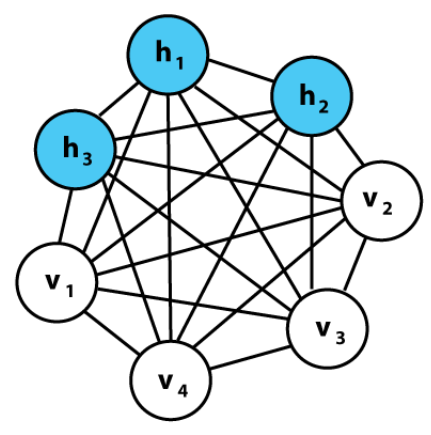
States
Types:
- Visible states
- Represent observed data
- Can be input/output data
- Hidden states
- Latent variable we want to learn
- Bias states
- Always one to encode the bias
Binary states
- unit value $\in \{0, 1\}$
Stochastic
Decision of whether state is active or not is stochastically
Depend on the input $$ z_{i}=b_{i}+\sum_{j} s_{j} w_{i j} $$
- $b_i$: Bias
- $S_j$: State $j$
- $w_{ij}$: Weight between state $j$ and state $i$
$$ p\left(s_{i}=1\right)=\frac{1}{1+e^{-z_{i}}} $$
Connections
Graph can be fully connected (no restrictions)
Unidircted: $$ w_{ij} = w_{ji} $$
No self connections: $$ w_{ii} = 0 $$
Energy
Energy of the network $$ \begin{aligned} E &= -S^TWS - b^TS \\ &= -\sum_{i<j} w_{i j} S_{i} S_{j}-\sum_{i} b_{i} s_{i} \end{aligned} $$ Probability of input vector $v$ $$ p(v)= \frac{e^{-E(v)}}{\displaystyle \sum_{u} e^{-E(u)}} $$ Updating the nodes
decrease the Energy of the network in average
reach Local Minimum (Equilibrium)
Stochastic process will avoid local minima $$ \begin{array}{c} p\left(s_{i}=1\right)=\frac{1}{1+e^{-z_{i}}} \\ z_{i}=\Delta E_{i}=E_{i=0}-E_{i=1} \end{array} $$
Simulated Annealing
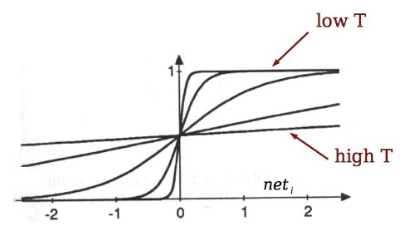
Use Temperature to allow for more changes in the beginning
Start with high temperature
“anneal” by slowing lowering T
Can escape from local minima 👏
Search Problem
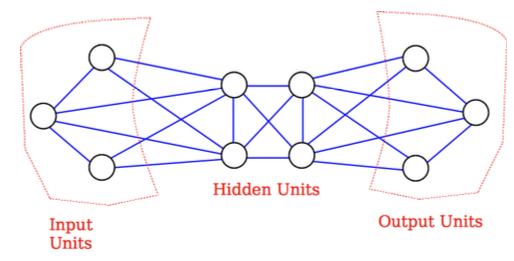
Input is set and fixed (clamped)
Annealing is done
Answer is presented at the output
Hidden units add extra representational power
Learning problem
Situations
- Present data vectors to the network
Problem
- Learn weights that generate these data with high probability
Approach
- Perform small updates on the weights
- Each time perform search problem
Pros & Cons
✅ Pros
- Boltzmann machine with enough hidden units can compute any function
⛔️ Cons
- Training is very slow and computational expensive 😢
Restricted Boltzmann Machine
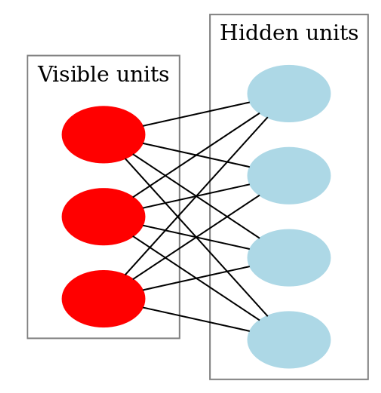
Boltzmann machine with restriction
Graph must be bipartite
Set of visible units
Set of hidden units
✅ Advantage
- No connection between hidden units
- Efficient training
Energy
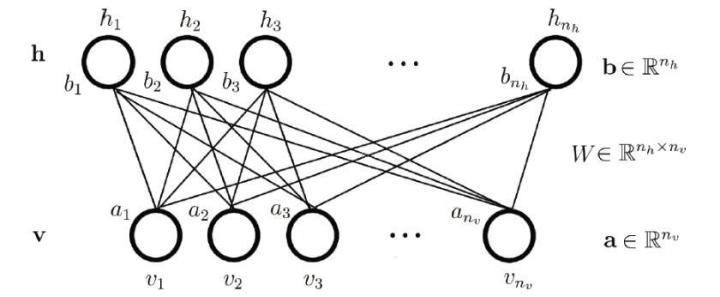
Energy: $$ \begin{aligned} E(v, h) &= -a^{\mathrm{T}} v-b^{\mathrm{T}} h-v^{\mathrm{T}} W h \\ &= -\sum_{i} a_{i} v_{i}-\sum_{j} b_{j} h_{j}-\sum_{i} \sum_{j} v_{i} w_{i j} h_{j} \end{aligned} $$ Probability of hidden unit: $$ p\left(h_{j}=1 \mid V\right)=\sigma\left(b_{j}+\sum_{i=1}^{m} W_{i j} v_{i}\right) $$ Probability of input vector: $$ p\left(v_{i} \mid H\right)=\sigma\left(a_{i}+\sum_{j=1}^{F} W_{i j} h_{j}\right) $$
$$ \sigma(x)=\frac{1}{1+e^{-x}} $$
Free Energy: $$ \begin{array}{l} e^{-F(V)}=\sum_{j=1}^{F} e^{-E(v, h)} \\ F(v)=-\sum_{i=1}^{m} v_{i} a_{i}-\sum_{j=1}^{F} \log \left(1+e^{z_{j}}\right) \\ z_{j}=b_{j}+\sum_{i=1}^{m} W_{i j} v_{i} \end{array} $$